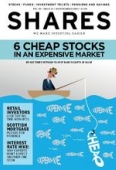Archived article
Please note that tax, investment, pension and ISA rules can change and the information and any views contained in this article may now be inaccurate.
The appeal of looking beyond the UK for dividends

The Bank of England’s recent move to raise UK interest rates from 0.25% to 0.5% reflects a determination to get a grip on inflation, often dubbed the ‘cruellest tax’, since it erodes savers’ purchasing power.
Those investors concerned by inflation and the impact of Brexit on domestic earnings may wish to consider some exposure to rising dividends generated away from the UK’s shores. One relevant product is investment trust Henderson International Income Trust (HINT).
The global equity income universe continues to be in good health and it is possible to find companies offering real dividend growth. Despite many overseas markets scaling new heights, equities still look attractively valued relative to bonds.
Dividend-income diversifier Henderson International Income Trust seeks to provide a high and rising level of dividends as well as capital appreciation over the medium to long term.
Ben Lofthouse has managed the trust since launch in 2011. A dividend seeking, valuation driven investor, Lofthouse looks for companies that have strong fundamentals, good balance sheets and attractive cash flow characteristics that can support growing dividends, tending to focus on companies that yield above 2%.
Diversifying your dividends
Importantly, Henderson International Income Trust looks to find these companies from across the globe but not the UK, offering investors the chance to diversify from any UK investments they may have, and in particular UK-based income generating stocks.
As at 30 September 2017, the portfolio’s exposure to the Americas, Europe and Asia Pacific stood at 34.4%, 40.2% and 26.5% respectively.
This is significant, as investors who focus solely on UK-listed firms, or the funds that invest in them, run the risk of significant income concentration.
‘More than 70% of the UK’s income as a market comes from the top 20 stocks,’ says Lofthouse. ‘We’ve undertaken never to own UK names, so we offer diversification,’ continues Lofthouse, who remarks that this alarming concentration of UK equity income hasn’t reduced in the years since Henderson International Income Trust’s launch. ‘If anything, it has gone the other way,’ he explains.
Payout progress
In the financial year to 31 August 2017, Henderson International Income Trust generated a total return of 18.8% in net asset value (NAV), including dividends of 4.9p per share, up a healthy 5.4% year-on-year. While that is a good performance, investors should not assume future returns will be the same. The value of investments can go down as well as up, so you could get back less than you invested.
The quarterly dividend payer’s ongoing charges figure (OCF), currently 0.88%, has reduced from 1.39% in the year of its launch as a result of asset growth and a reduction in fees in April last year.
The trust has also grown significantly since launch; net assets nearly doubling in size to around £200m in 2016 after combining assets with Henderson Global Trust and through the issuance of shares to boost liquidity, broaden wealth manager demand and lower charges.
‘Dividend growth has been good in the portfolio and widely spread across sectors and regions,’ says Lofthouse, addressing last year’s performance.
The investment trust’s valuation discipline often leads Lofthouse to invest in out-of-favour sectors and regions. Europe has been the largest regional exposure in the portfolio for some time, and an economic recovery has seen strong performance over the past year from a number of European stocks.
Some of last year’s largest dividend increases came from the likes of Dutch bank Van Lanschot, and French banks Natixis and BNP Paribas.
Stronger balance sheets and clearer regulatory requirements regarding capital levels enabled those names to pay larger distributions.
Driven by earnings growth, others to materially increase their shareholder rewards included smartphones leader Samsung, logistics leviathan Deutsche Post and soft drinks distributor Coca-Cola European Partners.
Avoiding value traps
Not averse to a turnaround tale, Lofthouse seeks to avoid value traps by ‘focusing on free cash flow’, a factor in the trust’s outperformance of peers since launch as ‘it is one way to avoid balance sheet problems’.
Another way of eschewing stock market disasters is ‘not reaching for too much yield’; since optically high yields are often a red flag for impending dividend cuts.
Lofthouse prefers to put investors’ money to work with industry leaders which benefit from economies of scale, diversification of earnings streams and also pricing power.
Exemplars in the portfolio include Samsung, offering a compelling combination of free cash flow growth, increased diversification and rising shareholder returns, software giant Microsoft and Best Buy, the number one US consumer electronics retailer.
‘We look for businesses that have consolidated,’ he says of the latter, a successful turnaround tale and dividend growth stock which has 30% market share, ‘and where there has already been a lot of pain.’
Emerging markets interest
Last year’s most significant change in portfolio composition was the increase in emerging markets exposure. This was mainly driven by new Chinese investments such as food manufacturer Dali and sportswear manufacturer/retailer Anta Sports.
‘Buying reasonably attractive income stocks through time has generally outperformed,’ insists Lofthouse, arguing his strategy has the potential to provide good returns to investors in a variety of market conditions.
‘It takes you away from bubbles, so you avoid excessive valuations,’ says Lofthouse, while even in a down market, dividends provide downside protection for patient portfolio builders. (JC)
Important information:
These articles are provided by Shares magazine which is published by AJ Bell Media, a part of AJ Bell. Shares is not written by AJ Bell.
Shares is provided for your general information and use and is not a personal recommendation to invest. It is not intended to be relied upon by you in making or not making any investment decisions. The investments referred to in these articles will not be suitable for all investors. If in doubt please seek appropriate independent financial advice.
Investors acting on the information in these articles do so at their own risk and AJ Bell Media and its staff do not accept liability for losses suffered by investors as a result of their investment decisions.
Issue contents
Big News
- Loss of confidence in UK IPO market
- Sweet and sour from ABF
- UK challenger bank in £1.1bn takeover
- Is GVC clearing the decks for Ladbrokes bid?
- Scottish Mortgage pleads for patience
- The fall-out from first rate rise in a decade
- Merry Christmas for Morrisons
- Why Indivior’s opioid addiction treatment is likely to be approved this month

 magazine
magazine










